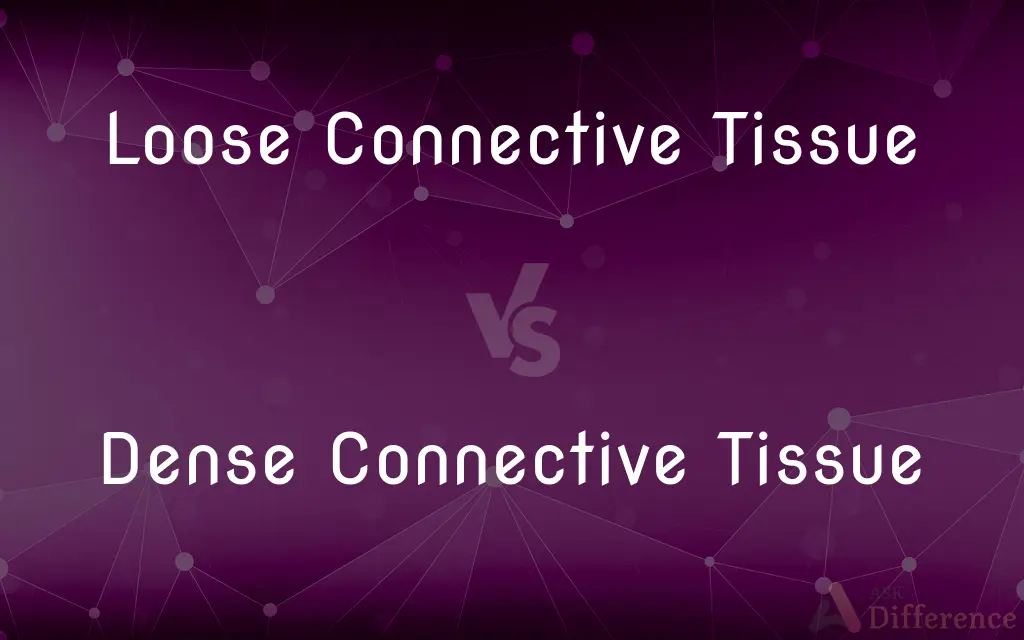Loose Connective Tissue vs. Dense Connective Tissue — What's the Difference?
Edited by Tayyaba Rehman — By Fiza Rafique — Published on December 13, 2023
Loose Connective Tissue has fewer fibers and more cells; Dense Connective Tissue has more fibers and fewer cells.

Difference Between Loose Connective Tissue and Dense Connective Tissue
Table of Contents
ADVERTISEMENT
Key Differences
Loose Connective Tissue is a type of connective tissue characterized by a loose arrangement of fibers and cells. This tissue provides a flexible framework that supports organs and provides a cushion. Dense Connective Tissue, on the other hand, has a more compact structure, with densely packed fibers and fewer cells. It provides tensile strength and can resist pulling forces.
In Loose Connective Tissue, the primary element is ground substance, a gel-like material that surrounds cells. This tissue type often contains collagen, elastin, and reticular fibers but in lesser amounts. Dense Connective Tissue primarily consists of collagen fibers, which provide it with strength and rigidity.
The various types of Loose Connective Tissue include areolar, adipose, and reticular tissues. These tissues can be found under the skin, around blood vessels, and supporting organs. Dense Connective Tissue is further divided into dense regular, dense irregular, and elastic tissues, which can be found in tendons, ligaments, and the dermis of the skin.
Loose Connective Tissue functions in providing support and nourishment to the surrounding tissues and helps in the storage of energy. Dense Connective Tissue primarily offers resistance and protection due to its densely packed fibers.
Loose Connective Tissue allows for more flexibility due to its less dense structure. It can stretch and move with ease. Dense Connective Tissue doesn't stretch as easily, giving it the ability to handle more stress and providing structural integrity.
ADVERTISEMENT
Comparison Chart
Fiber Density
Fewer fibers
Densely packed fibers
Cell Density
More cells
Fewer cells
Locations
Under skin, around vessels
Tendons, ligaments, dermis
Elasticity/Flexibility
More flexible
Less flexible
Primary Functions
Support, nourishment, energy storage
Resistance, protection
Compare with Definitions
Loose Connective Tissue
Tissue that provides support and nourishment with a gel-like ground substance.
Areolar tissue, a form of Loose Connective Tissue, surrounds organs.
Dense Connective Tissue
Tissue that provides structural integrity due to its densely packed fibers.
The inelastic nature of tendons is attributed to their Dense Connective Tissue composition.
Loose Connective Tissue
Connective tissue characterized by a loose arrangement of fibers and cells.
The Loose Connective Tissue under the skin provides cushioning.
Dense Connective Tissue
A tissue with densely packed collagen fibers and reduced cellularity.
Tendons are made of Dense Connective Tissue, connecting muscles to bones.
Loose Connective Tissue
A flexible framework tissue with fewer collagen fibers.
The elasticity of the skin is partly due to its underlying Loose Connective Tissue.
Dense Connective Tissue
Tissue primarily composed of collagen fibers, offering rigidity.
Ligaments, composed of Dense Connective Tissue, connect bones together.
Loose Connective Tissue
A tissue with a sparse concentration of fibers and abundant cells.
Adipose tissue, a type of Loose Connective Tissue, stores fat.
Dense Connective Tissue
A less flexible but strong type of connective tissue.
The reason scars are firm is due to the Dense Connective Tissue formation.
Loose Connective Tissue
Tissue that connects, separates, and supports other tissues and organs.
Loose Connective Tissue aids in cushioning muscles.
Dense Connective Tissue
Connective tissue that provides tensile strength and resistance.
The dermis of the skin contains Dense Connective Tissue, giving it strength.
Common Curiosities
What is the primary difference between Loose Connective Tissue and Dense Connective Tissue?
Loose Connective Tissue has fewer fibers and more cells, while Dense Connective Tissue has densely packed fibers and fewer cells.
Where can Loose Connective Tissue be commonly found?
It can be found under the skin, around blood vessels, and supporting organs.
Which tissue type is more flexible: Loose Connective Tissue or Dense Connective Tissue?
Loose Connective Tissue is more flexible due to its less dense structure.
Is adipose tissue a type of Loose Connective Tissue or Dense Connective Tissue?
Adipose tissue is a type of Loose Connective Tissue.
What is the main structural component of Dense Connective Tissue?
Dense Connective Tissue primarily consists of collagen fibers.
Can Dense Connective Tissue stretch easily?
No, Dense Connective Tissue doesn't stretch as easily, giving it more strength.
What functions does Loose Connective Tissue serve?
It provides support, nourishment, and helps in the storage of energy.
Why are tendons firm and inelastic?
Because they are made of Dense Connective Tissue, which provides them strength.
Why does the skin have elasticity?
Partly due to the underlying Loose Connective Tissue.
What gives tendons their ability to handle stress?
The Dense Connective Tissue composition gives tendons their strength.
What are ligaments made of?
Ligaments are composed of Dense Connective Tissue.
Does Loose Connective Tissue play a role in fat storage?
Yes, adipose tissue, a type of Loose Connective Tissue, stores fat.
What are the types of Dense Connective Tissue?
They include dense regular, dense irregular, and elastic tissues.
Which tissue, Loose Connective Tissue or Dense Connective Tissue, contains more collagen?
Dense Connective Tissue contains more collagen fibers.
Between Loose Connective Tissue and Dense Connective Tissue, which one has a more gel-like ground substance?
Loose Connective Tissue has a more gel-like ground substance.
Share Your Discovery

Previous Comparison
Imax 2D vs. 2D
Next Comparison
Nucleotide vs. Nucleic AcidAuthor Spotlight
Written by
Fiza RafiqueFiza Rafique is a skilled content writer at AskDifference.com, where she meticulously refines and enhances written pieces. Drawing from her vast editorial expertise, Fiza ensures clarity, accuracy, and precision in every article. Passionate about language, she continually seeks to elevate the quality of content for readers worldwide.
Edited by
Tayyaba RehmanTayyaba Rehman is a distinguished writer, currently serving as a primary contributor to askdifference.com. As a researcher in semantics and etymology, Tayyaba's passion for the complexity of languages and their distinctions has found a perfect home on the platform. Tayyaba delves into the intricacies of language, distinguishing between commonly confused words and phrases, thereby providing clarity for readers worldwide.















































